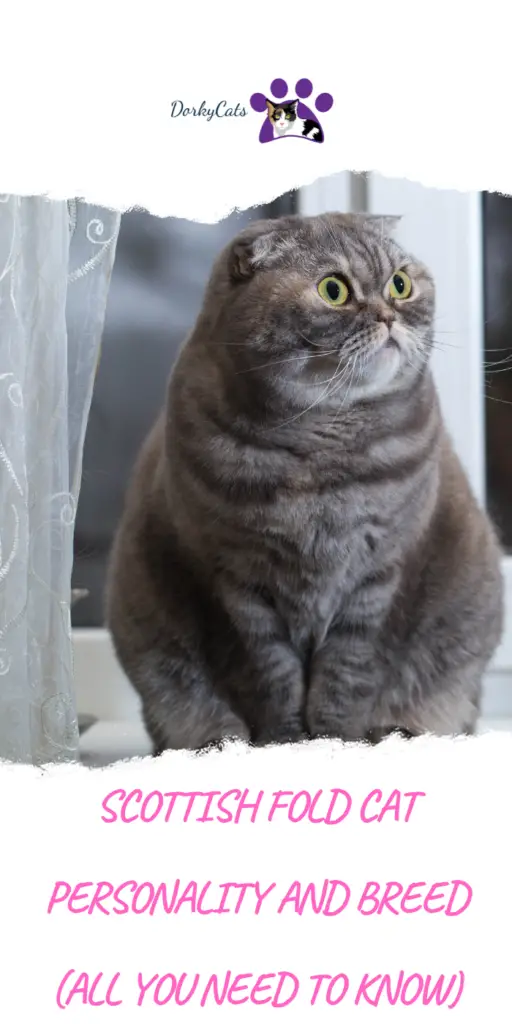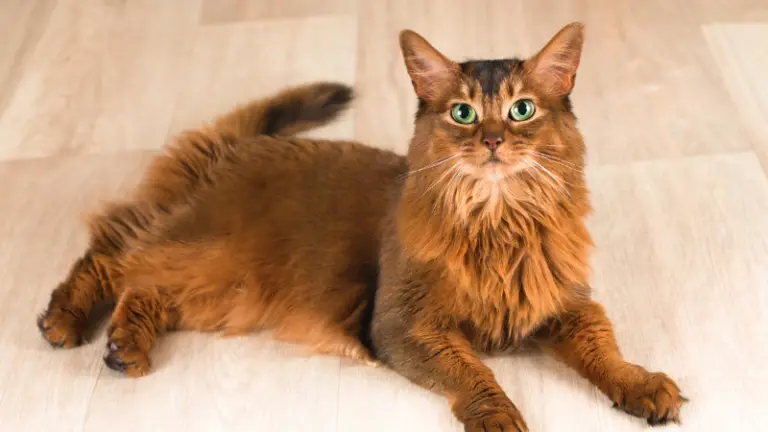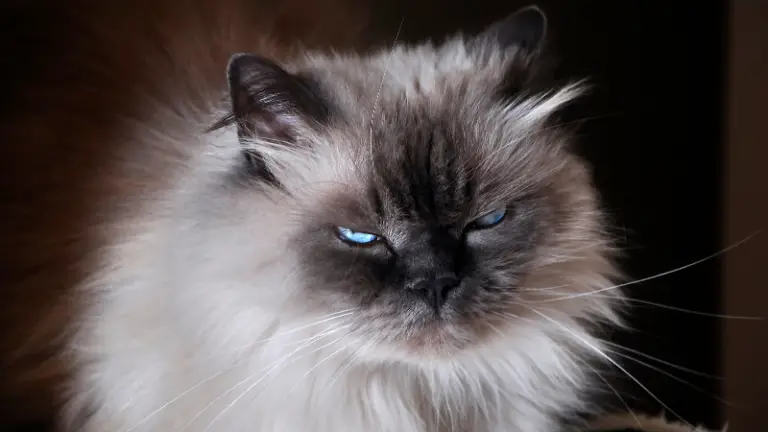SCOTTISH FOLD CAT PERSONALITY AND BREED (ALL YOU NEED TO KNOW)
Would you like to know more about the Scottish Fold cat personality? The pleasant appearance and friendly nature of the Scottish Fold have made him a trendy cat, especially in North America, where the breed was developed above all for exhibitions.
At a glance, the Scottish Fold has mobile and folded ears and looks like the British Shorthair. He is meek, gets along well with humans, and is affectionate but quiet.
Here is all you need to know about the Scottish Fold cat personality.

WHAT IS THE SCOTTISH FOLD GENERAL ASPECT AND SIZE?
The characteristic appearance of this cat, whose ears fold forward towards the front of the head, is the consequence of a natural genetic mutation.
The mantle is short, and it shouldn’t be brushed as much. However, there are also long-haired varieties.
CHARACTERISTICS OF THE SCOTTISH FOLD CAT:
| Characteristic | Description | Notes |
|---|---|---|
| In summary | With an unmistakable appearance, it is reproduced in a wide range of colors and patterns | When they are just born, the Scottish Fold cats have their ears erect like other kittens of the same litter |
| Personality | Affectionate and adaptable, and of a rather quiet nature | |
| Appearance | Particular appearance due to the folded ears, while the body is similar to that of the Brit- ish Shorthair | As with the British Shorthair, the males are bigger than the females |
| In the house | He has no problem living at home, but he also loves scouring the outside | |
| Behavior | Quiet by nature, he often prefers to sleep belly up and not sideways | |
| Grooming | Brush the coat at least once a week, more often when shedding | |
| Most common health problems | Scottish Folds cannot mate with each other, because bone problems can arise | |
| Size | Medium-large, from 2.5 to 6 kg | |
| Ears | Small, well spaced, with rounded points and folded down | |
| Eyes | Round, large, and well spaced | |
| Head | Wide, round, broad forehead and sturdy, short neck | |
| Paws | Short, with powerful muscles; feet wide and round | |
| Coat | Short, soft in texture, often raised from the body, and very elastic | |
| Admitted colors | All basic colors and coat designs of the British Shorthair and American Curl Shorthair |
WHAT IS THE HISTORY OF THE SCOTTISH FOLD CAT?
These cats originated from an unexpected mutation and appeared in 1961 in a litter born on a farm near Coupar Angus in Perthshire, Scotland. A shepherd named William Ross adopted a white kitten, Susie, from which all modern Scottish Fold cats are derived.
Unfortunately, Susie died still young due to a traffic accident, but not before giving birth to another kitten with folded ears, Snooks, who carried the line of descent forward.
In the beginning, there were a lot of discussions about this breed because it was feared that the cats were deaf, a concern that turned out to be unfounded despite their ears produce more ear wax than usual.
UNDERSTANDING THE SCOTTISH FOLD BREED
It soon became apparent that to pair a Scottish Fold with a normal-eared cat would have resulted in a high percentage of Scottish offspring, confirming that it is a dominant mutation.
The most crucial factor is that two cats of this same breed cannot mate with each other since a percentage of the litter will be affected by arthritic problems.
In the United States – where they have become popular after the initial refusal of British breeders – the crossings have been made with American Shorthair and British Shorthair, which have increased the breed’s size.
WHAT IS THE ORIGIN OF THE SCOTTISH FOLD?
The history of the Scottish Fold begins in 1961 when the Scottish Shepherd William Ross couldn’t help but notice the strange folded ears of a white stray near Coupar Angus in the Tayside region in Scotland.
The singularity of the kitten struck the shepherd, who started to ask for information and found out that it was a cat without a pedigree, a female named Susie belonging to an acquaintance of him.
Unfortunately, the pastor could not discover much about the cat’s past, except that her mother had common white ears. Nevertheless, Mr. Ross and his wife Maria fell in love with Susie, and when she gave birth a year later to two kittens also showing those strange ears, they decided to adopt one which they called Snooks.
At this point, the spouses began a breeding program to stabilize such a fascinating peculiarity:
- As a result, on 76 kittens born in the first three years of work, 42 had folded ears.

They attended several cat shows, talked with experienced breeders, and decided to call the new breed “lop-eared,” like the variety of rabbits with the same characteristic.
1966 was the year in which the lop-eared got registration of the breed from the CFA board of directors and, supported by other enthusiasts, began the long way to official recognition.
The 1970s were quite controversial for the Ross spouses: their breed was renamed Scottish Fold, but the GCCF revoked the registration because of the disturbances caused by the bending in the ears of cats, such as infections, mites, and hearing problems.
To finally see the Scottish recognized Fold, Mr. and Mrs. Ross were forced to bring them to America, where some specimens were sent to Dr. Neil Todd of the Carnivore Genetics Research Center in Massachusetts to carry out more in-depth research on the mutation of the ears.
Some of the cats coming from Scotland were adopted by Salle Wolfe Peters and taken to Pennsylvania. Wolfe Peters would later become the primary person responsible for the breed’s development on American soil.
Other specimens were imported into the United States, and the step to official recognition of the race was short after that. The Scottish Fold finally got access to the championship in 1978.
All Scottish Fold descendants carry a little of the blood of the white kitten named Susie.
TOWARDS RECOGNITION OF THE SCOTTISH FOLD
The journey towards official recognition of the Scottish, Fold began in 1973 when the CFA accepted the race registration. Five years after the shorthaired Scottish Fold was recognized by all associations and in a short time, it became part of the first
ten most popular breeds.
The long-haired variety obtained recognition only in 1980.
THE MUTATION OF THE SCOTTISH FOLD
The funny and folded-down ears make the Scottish Fold unique, which makes this cat similar to an owl.
But what determines the so fascinating feature of this race? The explanation lies in a dominant gene that determines the ears’ peculiar shape. Therefore, this gene must be present in at least one of the parents.
But it is not said, however, that the ears of these cats are all the same. They can, in fact, show up with a single fold, but also with a double or even triple one. The progenitor of this breed had one single Fold, for example.
To have the right to participate in an exhibition, the Scottish Fold must possess a triple fold, i.e., the ears must be adherent to the head.
Over the years, the selective program of this race has gradually improved, but this does not mean that a pairing performed superficially will not result in kittens with severe malformations.
To prevent kittens from being born with bone problems, it is essential never to cross two subjects carriers of the gene responsible for the folding of the ears.
SCOTTISH FOLD CAT PERSONALITY

The Scottish Fold is one of the most popular affectionate breeds.
It binds deeply to every single member of the family, with whom he consistently shows himself docile, good, and kind. He likes to participate in domestic life without ever being actively intrusive.
He has a soft, subdued meow that he rarely uses to manifest his needs, but he uses without hesitation to express all his disappointment when something is not to his liking.
With children, the Scottish Fold is never aggressive and hardly becomes impetuous even in moments of play.
▷ The Scottish Fold is a very tender comrades who fill our lives with immense love.
Being alone at home for many hours is a real torment for the Scottish Fold, so if you already know you can’t guarantee him your presence all day long, it is highly recommended to add a playmate, such as a dog or a cat. It makes no difference.
Born for apartment life, in reality, it hides a natural preference for open spaces where it can give free rein to its exquisitely predatory nature.
Scottish Folds love to hide their favorite toys in a secret place, so do not scold them for this behavior.
HOW TO CARE FOR AND FEED THE SCOTTISH FOLD CAT
The more specific treatments are obviously those required from his funny ears, whose cleaning must always be carried out with extreme delicacy and regularly, paying particular attention to accumulated ear wax between the folds.
As for the coat, weekly brushing is sufficient and needs to be intensified during molting. A balanced diet based on top-quality packaged food is ideal for the Scottish Fold.
TOP CURIOSITIES ABOUT THE SCOTTISH FOLD CAT
Here are some of the greatest curiosities about the Scottish Fold cat:
- GENETIC ANOMALIES: the gene responsible for ear folding is dominant. This means that if a subject has two copies of the same gene will likely develop a whole host of problems, including bone malformations and cardiomyopathy.
- The recognized color varieties are endless for the Scottish Fold.
- Scottish Fold litters count on average from 3 to 6 kittens.
- The Scottish Fold is one of the gentler breeds.
- THE FOLDING OF THE EARS: Scottish Folds have straight ears at birth. The folding of the ears, which distinguishes this breed, begins when the kittens approach the third week, giving the possibility to breeders to understand which specimens will develop this peculiarity.
- Don’t be afraid to let your Scottish Fold out in winter because it is a strong and vigorous breed that does not suffer even in the coldest temperatures.
- Run your hand gently along the entire length of the tail to control its flexibility and rule out joint problems.
- In the selection of the breed, the British Shorthair is often used.
- If ear cleaning is neglected, the Scottish Fold can risk infections in multiple forms; the most severe can impair hearing.
- For the Scottish Fold, making friends with house dogs is not unusual.
- For the Scottish Fold, it is not so important what he eats as far as always having the opportunity to eat a meal with his family.
- The long-haired variety is better known as the Highland Fold or Coupari. Breeders can obtain him by crossing the shorthaired Scottish Fold with a Persian.
- Within a litter, there can be kittens with different folds or devoid of this characteristic.
- The kittens are inseparable from the mother until the end of the third month.
IS IT ETHICAL TO ADOPT A SCOTTISH FOLD CAT?
With recent research, new data came to light explaining why all Scottish Fold cats suffer from osteochondrodysplasia, a painful bone disease.
While breeders tried not to cross the two Scottish Folds to prevent hereditary diseases, it is clear that all cats with folded ears have a gene causing cartilage defects (the same gene causing the unique folded ears of the Scottish Fold).
This means that a cat with folded ears will develop a bone problem.
Many vets and the UK GCCF believe it is unethical to breed a species that will live all life in pain. However, there are still debates about it, while the Scottish Fold remains a trendy cat in the US, Japan, and many other countries.
Remember that if you adopt a Scottish Fold, there is a risk for you to have to treat your cat for cartilage problems, which is very painful for the cat, and also expensive for the medications and treatments required.
FREQUENTLY ASKED QUESTIONS
What is the Scottish Fold cat price?
The Scottish Fold price can vary greatly, and it can be between $200 and $2000. The price depends on the age of the kitten, the breeder, and the purity of the breed.
What is the Scottish Fold lifespan?
The Scottish Fold can live up to 15 years. The cat’s lifespan can vary depending on the care, food quality, and other factors.
Are Scottish Fold in pain?
Scottish Folds are not always in pain, but they can suffer from a degenerating joint disease, which can be painful. This health problem causes a reluctance to move, an abnormal posture, and other issues.
The unique ear shape is caused by a defect in the formation of cartilage. Without this defect, the ears would be typically shaped like other cats.
But this cartilage defect also manifests in other parts of the body in what is called the Scottish Fold disease, or Osteochondrodysplasia. A vet discovered that all Scottish Fold would develop this disease, and all those cats would have a pain-filled life.
Why are Scottish Fold cats banned?
Scottish folds were banned by the GCCF (Governing Council of the Cat Fancy) in the 1970s, and it stands ever since. The GCCF is a cat registry based in the UK and has banned the Scottish Fold cat because of the genetic mutation that provides the unique ears shape.
The GCCF considered the mutation to be painful to the cats. However, the Scottish fold breed is registered as a breed in the rest of the world.
Are Scottish Fold cats smart?
Scottish Fold cats are generally loving cats and are smart like most cats. They like to play, chase toys, explore and do many other things that cats usually do.
Are Scottish Fold cats aggressive?
Sottish Fold cats are not aggressive; they are known to be the most lovable cat breed today. These cats are definitively not aggressive and get along with humans and other pets.
Do Scottish Fold cats like to be held?
Although Scottish Fold cats are very friendly and lovable pets, they do not like being held for long periods. Instead, they like other forms of affection, like scratches, being near you, and other things.
Can Scottish Fold cats be left alone?
A Scottish Fold does not like to be left alone. So if you adopt this cat, and if you know that you have to live for work many hours a day, it is better to adopt another cat or dog, so he has a playmate and a friend during the day.
Do Scottish Fold cats like to cuddle?
A Scottish Fold is an amiable cat who likes to cuddle with its humans and other pets, such as dogs and cats.
Do Scottish Folds meow a lot?
Scottish Fold does not meow a lot; when they do, they generate a soft and melodic sound, which is not very loud.







